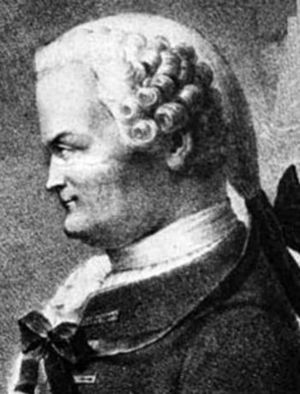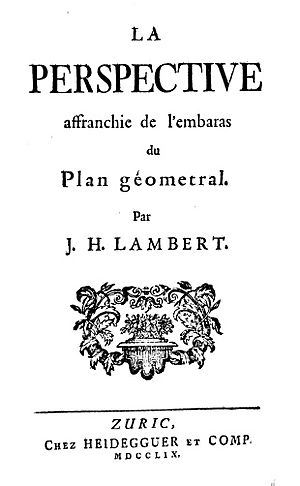Johann Heinrich Lambert facts for kids
Quick facts for kids
Johann Heinrich Lambert
|
|
|---|---|

Johann Heinrich Lambert (1728–1777)
|
|
| Born | 26 or 28 August 1728 |
| Died | 25 September 1777 (aged 49) |
| Nationality | Republic of Mulhouse, Swiss, French |
| Known for | First Proof that π is irrational Beer–Lambert law Lambert's cosine law Transverse Mercator projection Lambert W function |
| Scientific career | |
| Fields | Mathematician, physicist, astronomer, and philosopher |
| Influences | Aristotle, Bacon, Euler, Wolff |
| Influenced | Mendelssohn |
Johann Heinrich Lambert was a brilliant scientist from the 1700s. He was born in Mulhouse (now part of France) in 1728. He was a true "polymath," meaning he was an expert in many different fields. Lambert made huge contributions to mathematics, physics (especially how light works), philosophy, astronomy, and mapmaking.
Contents
Biography of Johann Heinrich Lambert
Lambert was born in 1728 in Mulhouse, a city that was then like its own small country, allied with Switzerland. His family were Huguenots, a group of French Protestants. Some records say he was born on August 26th, others on August 28th.
He left school when he was only 12 years old. But that didn't stop him from learning! He kept studying in his free time while working many different jobs. He helped his father, who was a tailor, and worked as a clerk at an iron factory. He was also a private tutor and a secretary for a newspaper.
When he was 20, he became a private tutor for the sons of Count Salis in Chur. From 1756 to 1758, he traveled all over Europe with his students. This trip allowed him to meet many famous mathematicians in places like Germany, the Netherlands, France, and Italy.
After returning to Chur, he published his first books about light and the universe. He then looked for a job at a university. In 1763, he was invited to join the Prussian Academy of Sciences in Berlin. There, he became friends with the famous mathematician Leonhard Euler. He also received support from King Frederick II of Prussia. This stable environment allowed him to work incredibly hard until he passed away in 1777.
Lambert's Scientific Work
Lambert's mind was always busy, and he explored many different areas of science.
Mathematics and Geometry
Lambert was the first to introduce hyperbolic functions into trigonometry. These are special mathematical functions related to hyperbolas, much like regular trigonometric functions (like sine and cosine) are related to circles.
He also made guesses about non-Euclidean geometry. This is a type of geometry where some of the usual rules, like parallel lines never meeting, don't apply. Imagine drawing shapes on a curved surface instead of a flat one.
One of Lambert's most famous achievements was proving that π is an irrational number. This means that π cannot be written as a simple fraction, and its decimal goes on forever without repeating. The famous mathematician Leonhard Euler believed this was true but couldn't prove it himself. Lambert used a special mathematical tool called a generalized continued fraction to show this.
Lambert also created new ways to calculate the paths, or orbits, of comets. His methods made these calculations much easier for astronomers.
He also developed a formula for hyperbolic triangles. These are triangles drawn on a curved surface that looks like a saddle. On such a surface, the angles inside a triangle add up to less than 180 degrees. The bigger the triangle, the smaller the sum of its angles. This is very different from triangles on a flat surface, where angles always add up to exactly 180 degrees.
Map Projections and Cartography
Lambert was the first mathematician to study the general rules of map projections. Map projections are ways to show the curved surface of the Earth on a flat map. He realized that you can't make a perfect flat map of the Earth. You can either preserve the correct shapes (called "conformality") or the correct areas ("equal area"), but not both at the same time.
In 1772, Lambert published seven new map projections. He didn't name them, but today they are known by his name or by what they do:
- Lambert conformal conic
- Transverse Mercator
- Lambert azimuthal equal area
- Lagrange projection
- Lambert cylindrical equal area
- Transverse cylindrical equal area
- Lambert conical equal area
The first three of these are still very important in mapmaking today.
Physics and Light
Lambert invented the first useful hygrometer, a tool that measures how much moisture is in the air.
In 1760, he published a book called Photometria, which was all about light. He showed that how bright something appears depends on how strong the light source is. It also depends on how far away the light is (the brightness decreases quickly with distance) and the angle at which the light hits a surface. He proved these ideas with experiments.
In Photometria, Lambert also talked about how light gets absorbed as it passes through something. This idea is now part of the Beer–Lambert law, which is used in chemistry and physics. He also created the term "albedo," which describes how much light a surface reflects. For example, fresh snow has a high albedo because it reflects a lot of light. The way a rough surface reflects light evenly in all directions is called Lambertian reflectance, named after him. He also wrote an important book about perspective and helped develop geometrical optics, which studies how light rays behave.
The unit of brightness called the lambert is named after him, recognizing his work in studying light. Lambert was also a pioneer in creating 3D color models. He described a triangular color pyramid that showed 107 different colors. It combined red, yellow, and blue pigments with increasing amounts of white.
Logic and Philosophy
In his main philosophy book, Neues Organon (meaning "New Organon"), published in 1764, Lambert explored how we can tell the difference between what we think or feel (subjective) and what is actually true (objective). This connected to his work on how we see things. This book was one of the first places where the word "phenomenology" appeared.
Lambert also exchanged letters with the famous philosopher Immanuel Kant. Kant even planned to dedicate one of his most important books to Lambert, but it was published after Lambert's death.
Astronomy and the Universe
Lambert developed a theory about how the universe formed, similar to the nebular hypothesis. This idea suggests that stars and planets form from giant clouds of gas and dust. Other scientists like Thomas Wright and Immanuel Kant also developed similar ideas independently.
Lambert suggested that the stars close to our Sun were part of a group that traveled together through the Milky Way galaxy. He also thought there were many such groups of stars throughout the galaxy. Later, the astronomer Sir William Herschel confirmed that stars do move in groups.
In astrodynamics, which is the study of how objects move in space, Lambert solved a problem about how long it takes for something to travel along a part of its orbit. This is now known as Lambert's problem. An Asteroid called 187 Lamberta is named in his honor.
Meteorology and Weather
Lambert believed that to understand weather, we should first observe regular weather patterns. Then, we could try to figure out the rules behind them and build a theory.
To get better weather data, Lambert suggested setting up a network of weather stations all over the world. These stations would record different weather conditions like rain, clouds, and dry periods. These methods are still used today! He also worked on making weather instruments better and creating clear ideas to help meteorology advance. This led to his published works in 1769 and 1771 on hygrometry and hygrometers.
Published Works
- Lambert, Johann Heinrich. "Pyrometrie; oder, Vom maasse des feuers und der wȧrme. Mit acht kupfertafeln." Berlin, Bey Haude und Spener, 1779.
See also
 In Spanish: Johann Heinrich Lambert para niños
In Spanish: Johann Heinrich Lambert para niños
- List of things named after Johann Lambert
- Asteroid 187 Lamberta
- Lambert (Martian crater)






